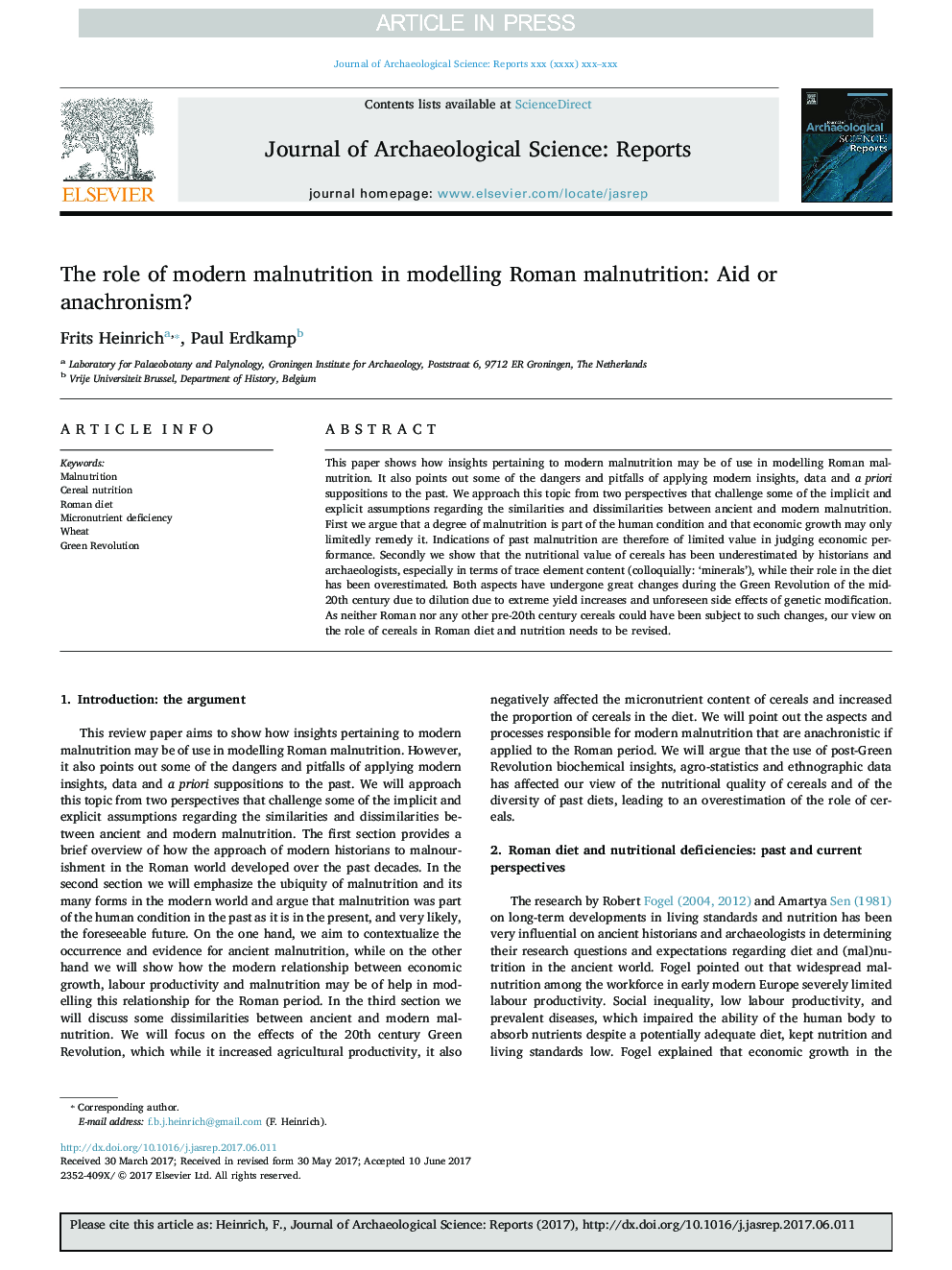| کد مقاله | کد نشریه | سال انتشار | مقاله انگلیسی | نسخه تمام متن |
|---|---|---|---|---|
| 7444418 | 1483924 | 2018 | 7 صفحه PDF | دانلود رایگان |
عنوان انگلیسی مقاله ISI
The role of modern malnutrition in modelling Roman malnutrition: Aid or anachronism?
ترجمه فارسی عنوان
نقش سوء تغذیه مدرن در مدل سازی سوء تغذیه رومی: کمک یا انحرافی؟
دانلود مقاله + سفارش ترجمه
دانلود مقاله ISI انگلیسی
رایگان برای ایرانیان
کلمات کلیدی
سوء تغذیه، تغذیه غلات، رژیم رومی، کمبود میکروارگانیسم، گندم، انقلاب سبز،
ترجمه چکیده
این مقاله نشان می دهد چگونه بینش های مربوط به سوء تغذیه مدرن ممکن است در مدل سازی سوء تغذیه روم استفاده شود. همچنین برخی از خطرات و خطرات استفاده از بینش های مدرن، داده ها و فرضیه های پیشین را به گذشته نشان می دهد. ما به این موضوع از دو دیدگاه نزدیک می شویم که بعضی از مفروضات ضمنی و صریح راجع به شباهت ها و تفاوت های بین سوء تغذیه باستانی و مدرن را به چالش می کشد. اولا ما استدلال می کنیم که میزان سوء تغذیه بخشی از شرایط انسان است و رشد اقتصادی تنها محدود می تواند آن را درمان کند. بنابراین نشانگرهای سوء تغذیه گذشته، در قضاوت عملکرد اقتصادی محدود است. ثانیا ما نشان می دهیم که ارزش تغذیه ای غلات به خاطر مورخان و باستان شناسان، به خصوص از لحاظ محتوای عناصر کمیاب (به طور خلاصه: "مواد معدنی")، کمتر شده است، در حالی که نقش آنها در رژیم بیش از حد است. هر دو جنبه در طول انقلاب سبز در اواسط قرن بیستم تغییرات بزرگی به علت رقیق شدن به علت افزایش شدید عملکرد و عوارض جانبی غیرمنتظره تغییرات ژنتیکی انجام شده است. همانطور که نه رومی و نه سایر غلات قرن پیش از قرن بیستم ممکن است چنین تغییراتی داشته باشند، دیدگاه ما در مورد نقش غلات در رژیم و تغذیه رومی ها باید تجدید نظر شود.
موضوعات مرتبط
علوم انسانی و اجتماعی
علوم انسانی و هنر
تاریخ
چکیده انگلیسی
This paper shows how insights pertaining to modern malnutrition may be of use in modelling Roman malnutrition. It also points out some of the dangers and pitfalls of applying modern insights, data and a priori suppositions to the past. We approach this topic from two perspectives that challenge some of the implicit and explicit assumptions regarding the similarities and dissimilarities between ancient and modern malnutrition. First we argue that a degree of malnutrition is part of the human condition and that economic growth may only limitedly remedy it. Indications of past malnutrition are therefore of limited value in judging economic performance. Secondly we show that the nutritional value of cereals has been underestimated by historians and archaeologists, especially in terms of trace element content (colloquially: 'minerals'), while their role in the diet has been overestimated. Both aspects have undergone great changes during the Green Revolution of the mid-20th century due to dilution due to extreme yield increases and unforeseen side effects of genetic modification. As neither Roman nor any other pre-20th century cereals could have been subject to such changes, our view on the role of cereals in Roman diet and nutrition needs to be revised.
ناشر
Database: Elsevier - ScienceDirect (ساینس دایرکت)
Journal: Journal of Archaeological Science: Reports - Volume 19, June 2018, Pages 1016-1022
Journal: Journal of Archaeological Science: Reports - Volume 19, June 2018, Pages 1016-1022
نویسندگان
Frits Heinrich, Paul Erdkamp,
